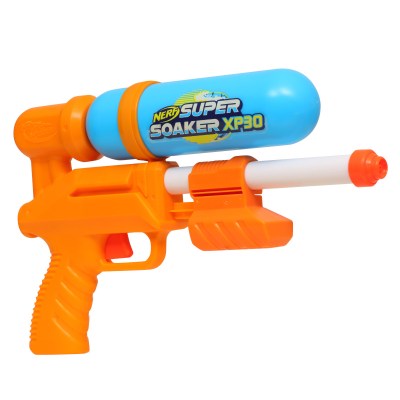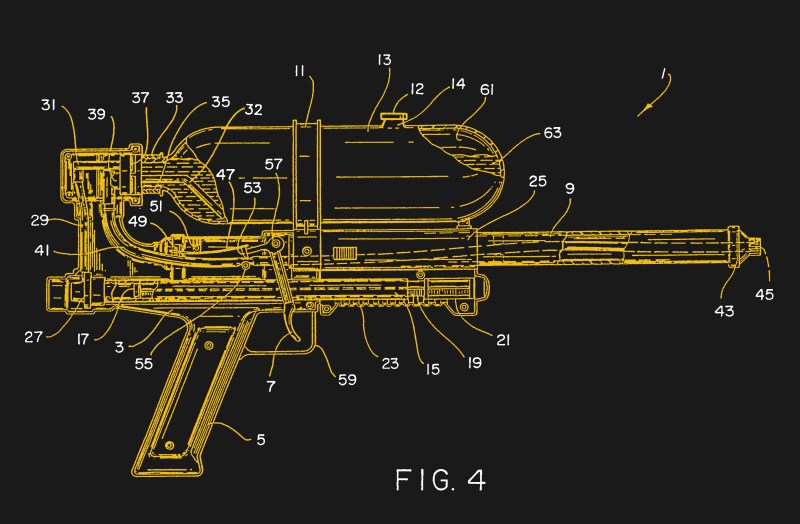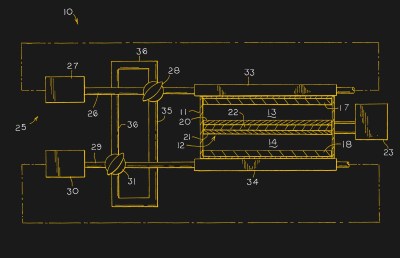
To be a child in the 1970s and 1980s was to be of the first generations to benefit from electronic technologies in your toys. As those lucky kids battled blocky 8-bit digital foes, the adults used to fret that it would rot their brains. Kids didn’t play outside nearly as much as generations past, because modern toys were seducing them to the small screen. Truth be told, when you could battle aliens with a virtual weapon that was in your imagination HUGE, how do you compete with that.
How those ’80s kids must have envied their younger siblings then when in 1990 one of the best toys ever was launched, a stored-pressure water gun which we know as the Super Soaker. Made of plastic, and not requiring batteries, it far outperformed all squirt guns that had come before it, rapidly becoming the hit toy of every sweltering summer day. The Super Soaker line of water pistols and guns redefined how much fun kids could have while getting each other drenched. No longer were the best water pistols the electric models which cost a fortune in batteries that your parents would surely refuse to replace — these did it better.
You likely know all about the Super Soaker, but you might not know it was invented by an aerospace engineer named Lonnie Johnson whose career included working on stealth technology and numerous projects with NASA.
The Inventor Of The Coolest Toy On Earth Also Worked on Some of the Coolest “Toys” in the Solar System

When you are a child, your thoughts never stray to where your toys come from. They’re just there, but maybe when you are a little bit older you begin to realise that somebody somewhere invented them and made your life just a bit more awesome. In the case of the Super Soaker, that somebody was not an anonymous team at a toy company but one man, a former US Air Force and NASA engineer named Dr. Lonnie Johnson.
In the stories of Lonnie Johnson’s early life in 1950s Mobile, Alabama, will be things that many Hackaday readers will recognise as the hallmark of a young hardware hacker. Dismantling the head of his sister’s doll to investigate its eye-closing mechanism, making rocket fuel in the family kitchen, or building a lawnmower-engine-powered kart. He recounts in interviews the support of his parents, after nearly burning the house down in the rocket fuel incident he was given a hotplate and told to continue outdoors rather than being punished.
In the final class at his high school to be racially segregated, he represented the institution at the Alabama State Science Fair in 1968 and took away first prize with a compressed-air-powered robot, before going on the next year to study mechanical engineering at Tuskegee University. He would finally graduate in 1973 with his mechanical engineering bachelors degree and a masters in nuclear engineering, going on to join the US Air Force where he would work on among other projects the nascent American stealth aircraft fleet. Lonnie spent about twelve years of his career at NASA’s Jet Propulsion Laboratory where he worked on Galileo, the Mars Observer, and Cassini, just to name a few.
The Brilliance of a Light Weight, High Pressure Tank

How does a nuclear engineer become the designer of the world’s most awesome water blaster? The story goes that as an early 1980s NASA engineer while working on a home side project heat pump that used water as its propellant, he would test its pump component and immediately recognise the fun inherent to a high-pressure jet of water shooting across his bathroom.

The path from there to 1990’s “Power Drencher” toy reaching the market and then being renamed “Super Soaker” was a long and tortuous one with multiple false starts. But his idea of using compressed air from a blown PET reservoir was a genuine innovation that changed the world of water blaster toys forever. This tank stored compressed air pressure instead of a heavier and more expensive to manufacture moulded part, giving a lightweight handheld enough power to propel an intense stream of water unlike any toys that came before it.
High-calibre engineering is worth its salt whether it is probing the outer reaches of the Solar System or defending a backyard from your invading elementary school classmates.
Not One To Sit On His Laurels…

If ever the earning of a fortune was well deserved then, it can be found in the work of Lonnie Johnson. But the story isn’t over, because instead of retiring on the proceeds of a brightly coloured water blaster, he has continued with the freedom to be that luckiest of engineers: one with the resources to choose his own work. His patents are legion, but probably those of most impact will be in the field of green energy. Through his Johnson R & D company he is pursuing a novel heat engine with the aim of achieving 80% efficiency in producing electrical power from heat. This implements an Ericsson thermodynamic cycle in a solid state device, with hydrogen gas passing through a proton exchange membrane between two electrodes that forms the equivalent of a regenerative heat exchanger. It’s still under development, but when it reaches the market it is likely to have a significant impact on the viability of solar power, as well as replacing heat pumps in many other applications.
So writing this from the opposite side of the ocean to his Atlanta base, Lonnie Johnson is one of my engineering heroes. He’s probably caused more spontaneous juvenile joy through his inventions than any other engineer of his generation, but his work both before and after the Super Soaker goes well beyond an awesome plastic toy. Giving gleeful kids the means to drench each other is what he’s known for today, but I’d put money on his fame in future decades being for cheap carbon-free energy.
















“Giving gleeful kids the means to drench each other is what he’s known for today,”
as well as drenching “unarmed” adults! civilian casualties B^)
Thanks for posting – I had an original Power Drencher with the “60 PSI Air Pressure” markings on the tank instead of the Super Soaker logo when I was growing up. I’d been wondering if the design had been sold to another company or just renamed.
Many great times had in neighborhood super soaker wars. The super soaker was a fun vehicle to train niece and nephew in basic squad-level tactics (and much criticism from wife and sister-in-law), hand and other non-verbal signals, fields of fire, and other stuff – but the essential element to this was were the lessons of weapons control and that CQB was insanity where the enemy had nothing to lose. Although I did not consciously design our war games to teach this lesson, that is what they said was learned. Super soakers are much fun and I recommend them for the 6 to 66 year range of kids.
Methinks we boomers were the last generation to have truly cool parents; and parenting certainly has changed over the years:
“… after nearly burning the house down in the rocket fuel incident he was given a hotplate and told to continue outdoors rather than being punished.”
Interesting to note that the idea for the front-end of his soaker evolved from his solution to a refrigeration problem. The mark of a brilliant engineer is to take a generic solution and use it to solve many different problems.
I’m Gen X, but my parents were the last who’d grown up through the war. My dad had a similarly cool attitude to such experimentation, I feel fortunate to have had that experience.
As a child I filled the garage with hydrochloric acid gas and left a thin layer of iron chloride on all the unprotected ferrous metal surfaces therein, but my experimentation was also only banished to the back yard.
Kids need (a controlled amount of) danger in their lives. They kids that do will always be several steps ahead of their contemporaries raised in a sterile suburban bubble with nothing dangerous. The kid with an adventurous childhood can grow up into a practical, useful adult who can solve problems and get things done outside the narrow scope of their most extensive area of formal training.
The thing is, society has gone over-cautious to the point that many of the common “experiments” are now impossible or require a photo-ID and put you into a permanent register somewhere. Buy a bag of stump remover, end up on terrorist watch list.
You can’t buy the required chemicals of parts any longer – for example, if you were to experiment with magnetics, you can’t find a good old transformer for copper wire anymore because they’re all tiny SMPS designs now with hair-thin wire potted with glue.
Yeah, remember the kid that built a nuclear reactor in his garage? :)
That kid “built” a radiation contaminated mess. He collected anything and everything he could find that was in any way radioactive. There was never any chance of it actually being a reactor and producing energy (or even a chain reaction.)
All he did was make a huge mess.
https://en.wikipedia.org/wiki/David_Hahn
I kinda want the prototype drawings… Looks like you could grab most of that on a Home Depot run.
Do you need the drawings? Do it!
But then I’ll end up upgrading everything to brass, then wondering if filling it with kerosene is a good idea.. … …
No. its not a good idea. That’s no reason not to do it.
If I may suggest, however: alcohol is nearly as much fun and quite a bit safer in many respects. Also, they sell pressure-able refillable steel “paint sprayers” for automotive use that charge from a compressor and offer *immense fun* possibilities.
Well I’ve got a couple of these kind of things hanging round that shoot 30ft or so…
https://www.bunnings.com.au/capital-8l-garden-pressure-sprayer_p2971502
From experience: rubbing alcohol in a super-soaker is disappointment. It’s hard to keep it lit up, it breaks the gaskets and it burns with a blue flame so you can’t even see it really.
But, if you drill out the nozzle of the gun (“shotgun mod”) to dump all the pressure at once – and extend it with the thin plastic tube from a coat hanger, and then pump the super soaker full of air instead – then you can fill the tube with rubbing alcohol, light a wick at the end and fire awesome movie fireballs into the air.
Acetone makes a nice low-temp flame.
acetone also makes super soakers (ABS plastic) disappear very quickly.
Um, Tuskegee
I had just finished high school when the Super Soaker came along, but that didn’t stop my friends and I from having water wars with them! You’re never too old to use a Super Soaker! Kudos to Lonnie Johnson!
…The best part was when I discovered that a 2-liter soda bottle fit nicely in place of the smaller reservoir my Super Soaker came with, allowing me to shoot for longer period of time and go longer between refills. I was the king of the hill for a day or two, until all my buddies adopted the same mod.
I remember my CPS 2500 I bought much later in high school. They used an heavy duty elastic reservoir-piston-thing to store pressure in that series. The thing was like a portable fire hose on full stream. You had to actually practice short trigger pulls like a submachine gun to get the most out of it because even a short slug of water would soak a shirt like a water balloon. An amazing piece of tech.
Same here, and with a little tinkering with the overpressure valve it became a even bigger menace.
Sadly, those were among the last of those that didn’t get nerfed in the fun department, and I lost mine in a move.
when i was 8 or 9 i think i invented a mod for the super soaker making it a shotgun of sorts. me and my sister both had one and she broke hers, dropping the nozzel ont he cement and breaking it. in my attempts to fix it i had discovered that you can drill out the nozzel in such a way as to make a shotgun. granted it would blow most of its tank, and you would get at most 2 shots. but it was worth it.
The cheap-o versions had a thin plastic hose inside the outer tube, and they used a spring to pinch on the hose to act as a valve. I was very disappointed when they changed the design and you couldn’t do the shotgun version any longer.
What a (watery) blast from the past! I had a Super Soaker 50, and quickly realized I could carry more “ammo” in pop bottles and swap them into place in just a few moments. The intake screen on the dip tube was fairly restrictive, and removing it (wrapping some heavy wire around the end of the tube instead, to make sure it stayed in the water) would noticeably increase the power.
However, the shape of the 50 meant it could only take 500mL and 20oz bottles, nothing larger except maybe the oddball skinny Coke promo bottles in the 1L size. I wanted more, so I set out building my own.
Two 3L bottles (Faygo came in these) would fit in an old backpack, with a bunch of aquarium tubing between them, glued on because aquarium fittings wouldn’t otherwise hold much pressure. I used a T-handle bicycle tire pump to pressurize the rig, which I lashed alongside the body of the SS50 for carrying. I still used the grip, valve, and nozzle of the original Super Soaker, with a hose running back to the pack. The hand-pump on the barrel still worked but it would fill the lines with air, plus it was way slower than the bike pump.
Six liters of ammo was enough to mow down entire sand castles…
Well, Stirling engine already exist.
Stirling engines have moving parts, maybe not that many, but they’re moving.
I am too old to have had my childhood blessed by the joys of a Super-Soaker… but the joy experienced last year by this over-60 geek firing a potato cannon for the first time has to be close…
ffTOOM! (…splat)
Yes but take a look at the second linked article. That fellow’s gadget worked. And I remember reading the book.
Potato cannons are very verboten.
Brass orifices degrade extremely fast with certain v common liquids. SS lasts reasonably. (See also, garden sprayers. Note the white ones.) Acetone is super bad to breathe. These things are all, ‘systems,’ and each change can demonstrate a new bug, and a new danger. This stuff ain’t fer kids, always. Remember your PPE and have your hazmat recovery system warmed up. Some of these can get you a dedly wepun chg. Safety & stelth.
Just noticed this article doing a search for “toys” since someone asked about wanting to add sounds to toys.
Wondering what happened to my super soakers? One of my favorite toys for sure and now days knowing more about air powered systems and guns even… makes me want to both buy one and try to make one.
Also wondering about making a higher pressure hand or foot pump based on the 3000 to 4000 psi pump designs. More an DIY AirForce Texan want and need… though a super soaker would just be fun even as a fire safety device justification.